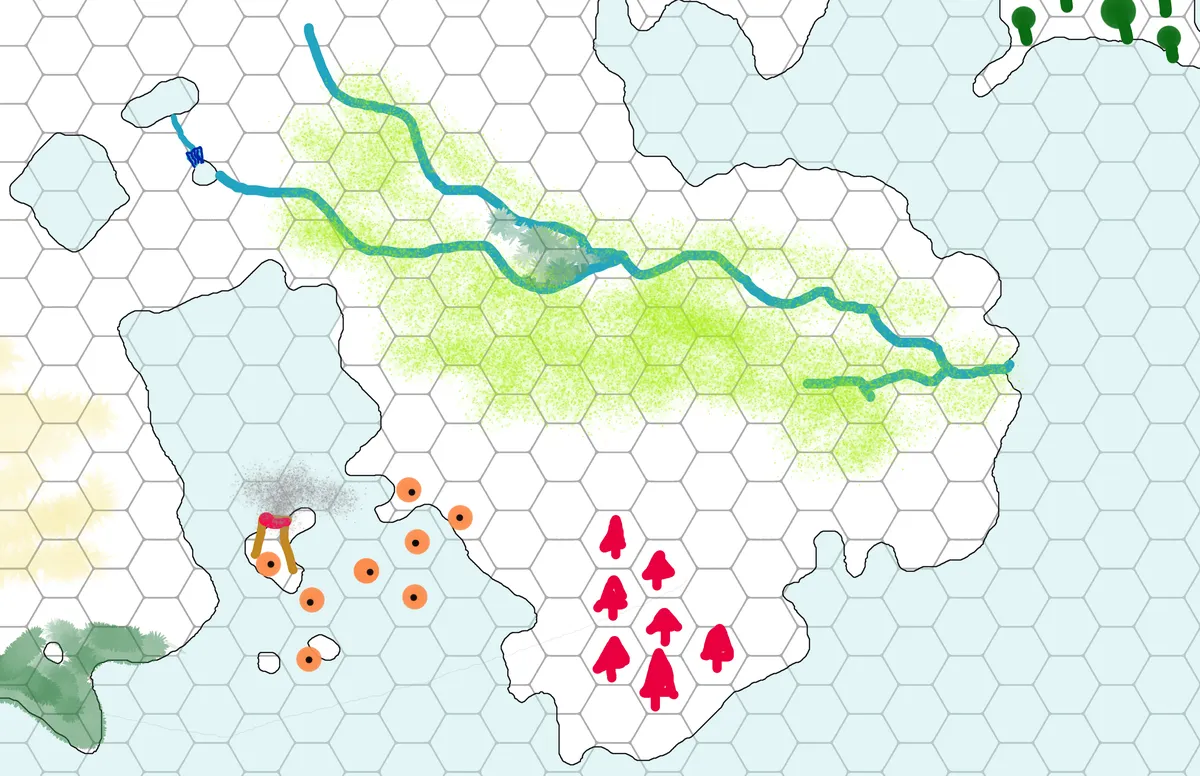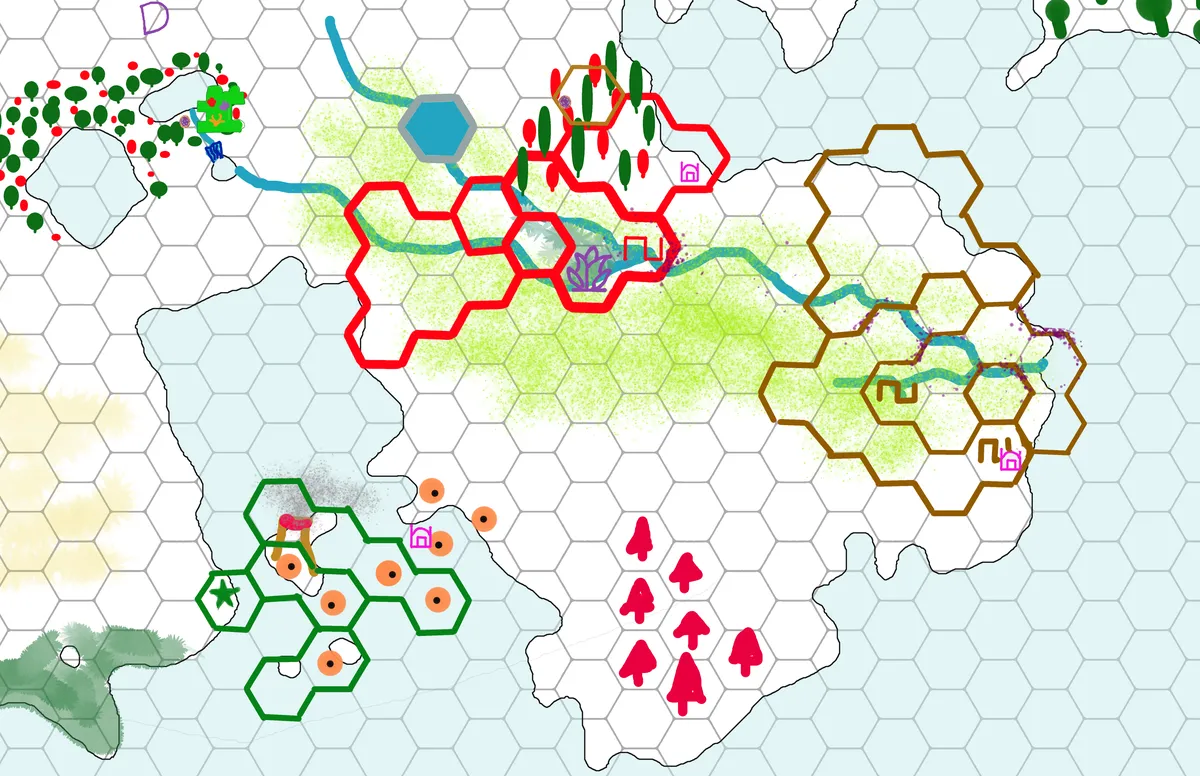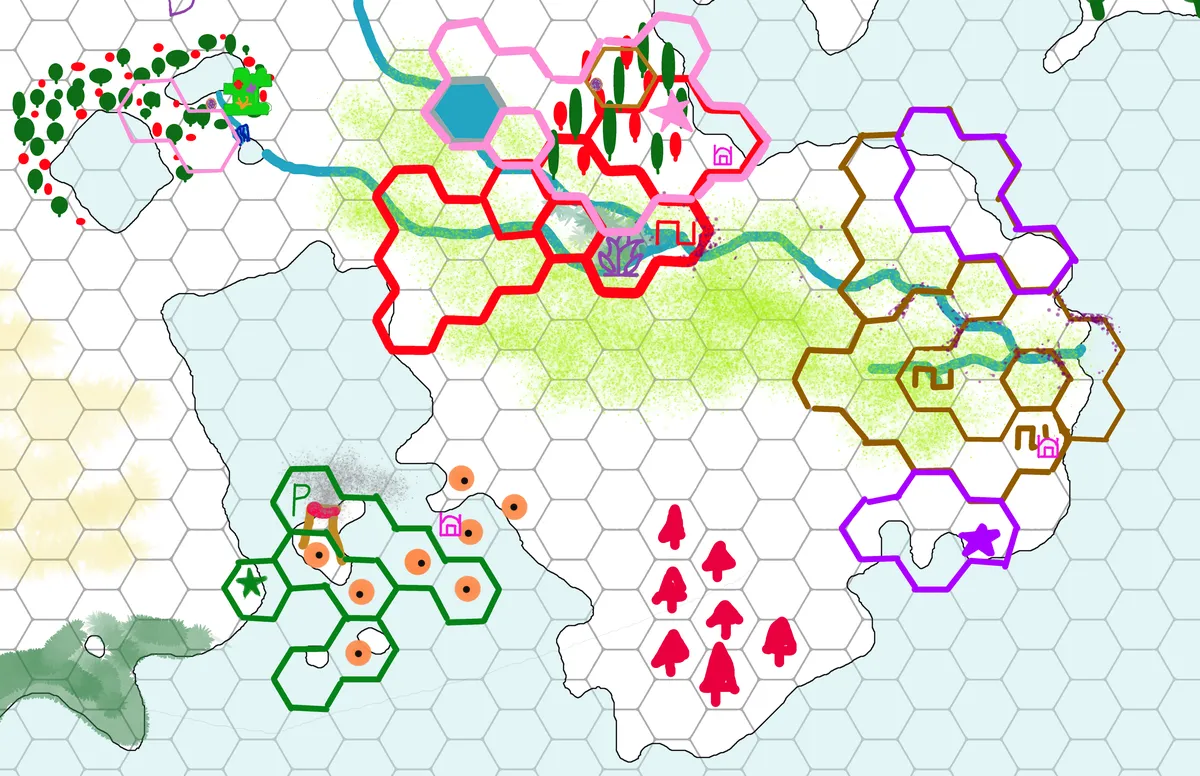Worldwizard
My gaming group wrapped-up a short campaign of Worldwizard, a lightweight worldbuilding game brought to you by Lampblack & Brimstone. The game pitches itself as a way to cooperatively build a world for your next fantasy tabletop campaign. I have reservations of whether it succeeds at building a playable world, but the experience of making one is a lot of fun!
You start the game by picking a hex-grid map, with the game providing you with eight to choose from at two different scales, as well as blank templates to make your own with. You're then encouraged to talk through broad ideas for the world, things to steer clear of, and what scale each hex is. After that, you start play, moving through four historic ages - Primordial, Prehistoric, Ancient, and Present. Each age follows a pattern, rotating from player-to-player and allowing each to spend points from a pool to draw terrain on the map, establish groups of people, create powerful individuals, and so-on. If you run out of points, you can gain more by having a disaster or event occur in the world. Each action other than disasters and events ticks-up a counter, and when that counter fills you either end the age or decide to go for another round.
 Primordial Age. A single peninsula from a much larger map. Players have placed down rivers, grassland, swamps, and mushroom forests. A waterfall connects the two lakes and a volcano sits on an island connected to the peninsula by underground caves.
Primordial Age. A single peninsula from a much larger map. Players have placed down rivers, grassland, swamps, and mushroom forests. A waterfall connects the two lakes and a volcano sits on an island connected to the peninsula by underground caves.
You roll dice at the end of each age to see if the people and heroes you created survive into the next era, with roughly even odds of survival or dying. If they survive, they advance and gain more options in the subsequent age. If they fail, they pass out of history, but only after making one final mark on it by performing some great work or deed. Play repeats for each age until you finish the Present Age, with the state of the world at that point in time becoming the setting for your next tabletop game.
To help you with making choices, the game includes several tables at the back you can roll on or peruse for ideas. The prompts are diverse, and can result in creating clannish slime people, monstrous shark swarms, and even meteor strikes. The entries are brief, and you're encouraged to rule a few to give shape to a given culture, person, or event.
My group played four sessions, roughly one per age. We had a lot of fun, excitedly building connections with each action taken. "Oh, the beast swam disaster I rolled must be a result of the giant, magical lily your slime wizard made upstream. The magic waters turned the fish into monsters that now threaten the catfolk farmers downriver." As play went on, it was easy to build off of each other's ideas - either rolled or self-generated - and create a world we were attached to at the end.
 Ancient Age. Three civilizations have grown across the land - dragonfolk in the southwest, clannish slime people in the north, and farming catfolk to the east. By the end of the Age, only the dragons continue as a civilization, with the other two leaving behind ruined cities. Forests full of tree-like mushrooms have sprung-up and an immortal slime wizard built a living tower near the lakes.
Ancient Age. Three civilizations have grown across the land - dragonfolk in the southwest, clannish slime people in the north, and farming catfolk to the east. By the end of the Age, only the dragons continue as a civilization, with the other two leaving behind ruined cities. Forests full of tree-like mushrooms have sprung-up and an immortal slime wizard built a living tower near the lakes.
For all it's fun, a couple things bothered me by the end. First, we chose much-too-large a map for just our three players. We struggled to fill every space of the map and had to consciously place groups next directly next to each other if we wanted them to interact. This problem was compounded by the tight turn counter, which we frequently ignored to go into "overtime" just to fill in more of the map. We plan to play again, but will choose a smaller map when we do.
I also am not sure it's effective at making a game you can play with most fantasy games unless your table is willing to put in some work tweaking the game's rules. We finished the game with a world filled with snake-haired pirates, volcano worshiping dragons, orcish Romans, isolated birdfolk, and pockets of catfolk, slime people, and mushroom men, all generated from the random tables in the back of the rulebook. Notably, none of these groups are standard to games like D&D or Old-School Essentials, which stick to a narrow range of character options - humans, elves, dwarves, halflings, etc. I made a conscious choice in the final age to add humans and elves, a move on my part to make sure we had something approaching "normal" player options if we decided to use the map for a game.
 Present Age. The peninsula now has extraplanar elves expanding over the territory one controlled by the slime people, while snake-haired sailors colonize the territory that used to be farmed by catfolk.
Present Age. The peninsula now has extraplanar elves expanding over the territory one controlled by the slime people, while snake-haired sailors colonize the territory that used to be farmed by catfolk.
These complaints are minor, though. They're the sort of thing you can address before play by having a conversation as a group about what you want the world to be, then holding yourself accountable to those choices. I had a lot of fun with Worldwizard and can see myself kicking off a tabletop campaign using it.